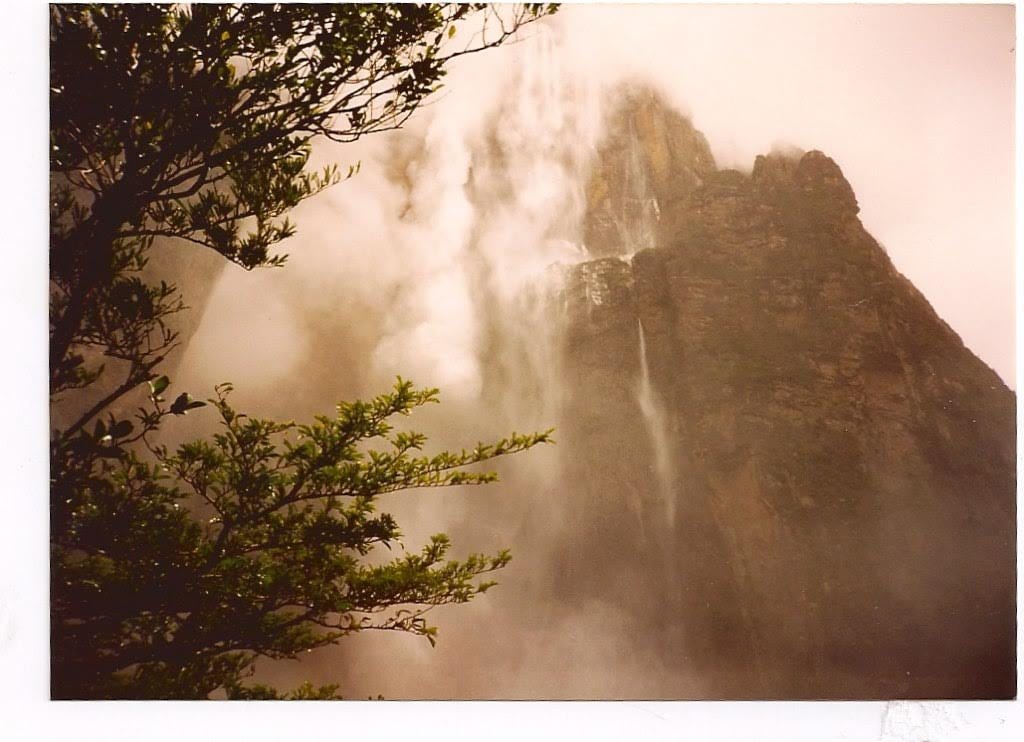When I think of the songs I admire the most, there’s a cascade of images you can see that tumbles through the song like water down a long thin waterfall.
I’m thinking a waterfall shaped like Angel Falls in Venezuela. Here’s a picture of Angel Falls I took in 1995 on a trip there. It stays in my consciousness.
The cascade of images. A central topic, object, image, will be introduced as the song opens and will tumble its way through, changing, being caught, turned around, sent on its way again, to arrive at the pool of understanding at the bottom of the falls, the end of the song.
I love the cascade of images because it contains in its structure all the best things about writing a really good song: an idea that turns and changes and moves you.
Sometimes you get lucky and a song falls out fully formed, with its cascade of images intact, because our brains can do beautiful things when we let them do what they want to do unhindered. My song ‘Hallelujah’ (not that ‘Hallelujah’, a different one), took eight years to write, but actually took 10 minutes twice, eight years apart. The piano part fell out of me on one day, and then eight years later I had to catch the lyrics on the inside of a loo roll whilst in the bath (this happens quite a lot). The words, like the music, birthed fully formed with a cascade of images about jewels and guardians and holy houses completely present. I guess my brain had been given eight years to knit it together quietly in the darkness.
In my mortal songwriter experience, this full cascade event is quite rare. More often than not, on my first song draft I might not have a cascade yet. This cascade-building business is then to be found in the redrafting.
There’ll be some image, some arresting person or being or object or colour or state, that has popped up somewhere in the song as it emerged in its nascent state. It may not be at the start. It might be in verse 3. But keep a look out for it.
This image will poke out like a sparkly jewel and wink at you. The cascade, in my experience, is usually a reverse engineering process. You take the sparkly image and you run backwards to the head of the waterfall, the top of the song, and you find interesting ways to tell the song’s story of itself through the manipulation of the image as it tumbles through the length of the song. Meaning unfolds itself. When you give it a chance to flow, it takes on its own life and starts making new meanings, often way beyond your control. And this is the meaning-making we seek — the flash of new splashes, unexpected pairings, images put together that you hadn’t seen before that make the brain think a new thought.
Here’s a brilliant example of a text-book cascade in action: a full-blooded alt-country song that makes me marvel at its structural heft called ‘Loose Change’ performed by The Highwomen, written by Maren Morris, Daniel Robin Layus and Maggie Chapman.
https://www.azlyrics.com/lyrics/highwomen/loosechange.html
Thinking on the topic of money, work your way through the song and watch the cascade of images shimmer and twist to tell the story of a jilted persona recovering a sense of confidence and self-worth after a cruel romantic break-up.
From shines, bucks, the titular loose change, flipping heads or tails, and differing concepts of value, we tumble through the song through a cascade of coins to arrive at the optimistic manifesting mantra ‘I’m gonna be somebody’s lucky penny some day’. The money image keeps twisting and curling to mean something different, but it creates unity in the song from top to bottom, allows us to see the waterfall, where we started, where we land.
The Beatles’ song ‘Blackbird’ is a more poetic, aesthetic, emotionally resonant example of this phenomenon. I don’t want to tell you too much at Paul McCartney’s brilliant entry in his book ‘The Lyrics’ about this song and what meanings he believes it carries. I know the magic it has held for me over the years and the love-lock embrace of images that tumble through the song of birds, wings, flying, existential pain and the darkest moment of the night.
https://www.thebeatles.com/blackbird
Some songwriters never redraft. They might say: the song came out that way, who am I to touch it? I say: yes and no; never say never; some songs do come out fully formed, but other great songs (the other ‘Hallelujah’, for example, which took some time to emerge) come out needing some crafting, and it’s our job to know the difference.
Exercise: next time you write a song, save your first draft. Nothing can touch it. Now hit ‘save as’ and see if you can find a sparkly image in that first draft that could be teased into a waterfall. Work on a second draft manipulating that image to thread it through your song from the start in some form to help tell the story. If it doesn’t work, nothing lost, you still have draft 1.
Please do send me any questions you may have about songs, songwriting, recording, process, or any other topics you are interested. I am always happy to try to answer them.
Thank you so much for supporting and reading.
Polly Paulusma is a recording artist with One Little Independent Records and Associate Professor of Song & Literature at The Institute of Contemporary Music Performance in London.
For up-to-date news of her gigs and releases, join the mailing list.
For more about her journey as an artist and a human, join her community at Patreon.


